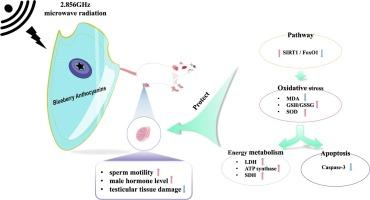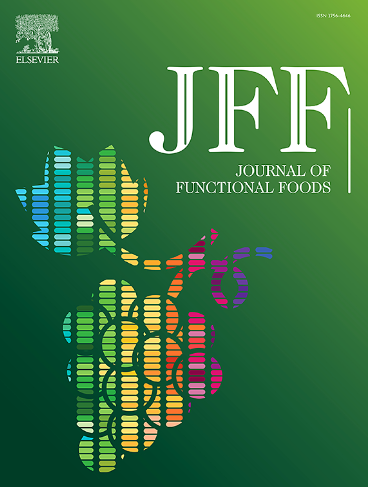Blueberry anthocyanins regulate SIRT1/FoxO1 pathway to inhibit oxidative stress and reduce testicular tissue damage induced by microwave radiation in rats
IF 3.8
2区 农林科学
Q2 FOOD SCIENCE & TECHNOLOGY
引用次数: 0
Abstract
Researches have shown that microwave radiation could cause oxidative stress injury in male reproductive system, and blueberry anthocyanins had excellent oxidation resistance. Our study aimed to investigate the protective effect of blueberry anthocyanins (100, 200 and 400 mg/kg/d) on testicular tissue damage in Wistar rats exposed to 2.856 GHz microwave and the optimal dose. We found that blueberry anthocyanins could ameliorate the decrease of sperm motility and sex hormone levels and testicular tissue structure damage caused by microwave radiation, increase SIRT1 expression and decrease FoxO1 expression, increase GSH/GSSG, SOD and inhibit MDA. The LDH, SDH and ATP synthase were increased, and Caspase-3 expression was decreased, and the high-dose of blueberry anthocyanins (400 mg/kg/d) had the best protective effect. These results suggested that blueberry anthocyanins could inhibit oxidative stress injury induced by 2.856 GHz microwave radiation in rat testicular tissue by regulating SIRT1/FoxO1 pathway, enhance energy metabolism and reduce cell apoptosis.

蓝莓花青素通过调节 SIRT1/FoxO1 通路来抑制氧化应激并减轻微波辐射对大鼠睾丸组织的损伤
研究表明,微波辐射会对男性生殖系统造成氧化应激损伤,而蓝莓花青素具有良好的抗氧化性。我们的研究旨在探讨蓝莓花青素(100、200 和 400 mg/kg/d)对暴露于 2.856 GHz 微波的 Wistar 大鼠睾丸组织损伤的保护作用及最佳剂量。我们发现,蓝莓花青素能改善微波辐射引起的精子活力和性激素水平下降及睾丸组织结构损伤,提高 SIRT1 表达,降低 FoxO1 表达,提高 GSH/GSSG、SOD,抑制 MDA。高剂量蓝莓花青素(400 mg/kg/d)的保护效果最好。这些结果表明,蓝莓花青素可通过调节SIRT1/FoxO1途径抑制2.856 GHz微波辐射对大鼠睾丸组织的氧化应激损伤,促进能量代谢,减少细胞凋亡。
本文章由计算机程序翻译,如有差异,请以英文原文为准。
求助全文
约1分钟内获得全文
求助全文
来源期刊

Journal of Functional Foods
FOOD SCIENCE & TECHNOLOGY-
CiteScore
9.60
自引率
1.80%
发文量
428
审稿时长
76 days
期刊介绍:
Journal of Functional Foods continues with the same aims and scope, editorial team, submission system and rigorous peer review. We give authors the possibility to publish their top-quality papers in a well-established leading journal in the food and nutrition fields. The Journal will keep its rigorous criteria to screen high impact research addressing relevant scientific topics and performed by sound methodologies.
The Journal of Functional Foods aims to bring together the results of fundamental and applied research into healthy foods and biologically active food ingredients.
The Journal is centered in the specific area at the boundaries among food technology, nutrition and health welcoming papers having a good interdisciplinary approach. The Journal will cover the fields of plant bioactives; dietary fibre, probiotics; functional lipids; bioactive peptides; vitamins, minerals and botanicals and other dietary supplements. Nutritional and technological aspects related to the development of functional foods and beverages are of core interest to the journal. Experimental works dealing with food digestion, bioavailability of food bioactives and on the mechanisms by which foods and their components are able to modulate physiological parameters connected with disease prevention are of particular interest as well as those dealing with personalized nutrition and nutritional needs in pathological subjects.
 求助内容:
求助内容: 应助结果提醒方式:
应助结果提醒方式:


